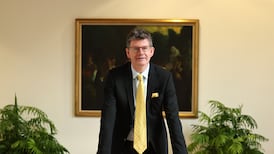The town of Cognac was devoid of Irish football fans when we stopped there on Monday, a remarkable fact in itself. But it has not been short of visitors from Ireland, historically, and the influence of one of them is still strongly felt.
Richard Hennessy left his native land in the mid-1700s, first to serve as an officer in the French army. Then he identified the commercial potential of a type of brandy for which Cognac-the-town was already well known. So in September 1765, together with partners named Connolly and Arthur, he signed the founding deed of a company to produce the drink.
Connolly and Arthur are footnotes now. But 250 years later, Hennessy is a prestigious brand name, known all over the world. In its visitor centre shop, one bottle has a price-tag of €3,600. Down in the cellars, meanwhile, where you could get drunk on the fumes, there are barrels dating from the 1800s, still maturing.
Cognac-the-drink, by the way, is made from certain types of white wine produced only in this region. The wines are very dry and acidic, and judged on their own merits would be barely palatable. But when subjected to double distilling, they become something much more special.
That, broadly speaking, is what Martin O'Neill needs to do with his Ireland team this week: take the poor-quality grapes life has dealt him and turn them into eau de vie. Certainly, the hope of Irish fans is that, having failed to make the grade in wine-rich Bordeaux, the team will be transformed into a spirit-based product on its return to northern climes, and surprise the Italians with how much of a kick it has.
As for Hennessy, although the company is much more corporate than it used to be, it does still have central involvement from the original Hiberno-French family.
Foreign missions
These are now eight generations removed from the old country, but not out of touch. One of the more recent heirs was a Kilian, named after a 7th-century Cavan-born missionary who travelled to Gaul and Germany.
Speaking of foreign missions, the Irish fans at Euro 2016 are continuing their own work to make the world a better place. When not spreading joy by their mere presence, or showing other Europeans how to have the craic, they go out of their way to perform good deeds: a phenomenon increasingly noted by the French media.
Monday night's news on the France 2 TV channel ran a feature contrasting the often violent behaviour of other supporters with the "civisme" and "joie de vivre" of the Irish. The item included a greatest hits collection of their "dozens of videos": including the street cleaning, the serenading of police, and the elevation to pope-like status of a "Parisien anonyme" on his balcony.
For these and other contributions to world peace, France 2 suggested the Irish fans deserve their own European Cup, separate from the one for which their team is still (officially, at least) competing.
But until such an award is made, the campaign continues. And speaking of peace, the fans have also now demonstrated that, when required, they can even keep the noise down. Until recently, this would not have been considered part of their celebratory repertoire, which tends to be of the Nessun Dorma ("none shall sleep") variety.
Then yet another video emerged in which, noticing a French couple with a baby on a Bordeaux tram, a group of Irish supporters lower their voices to sing lullabies, including Twinkle Twinkle Little Star. The child does not fall asleep at any point in the video. But it does remain impressively calm throughout the performance, during which it is also swaddled gently in a Tricolour.










